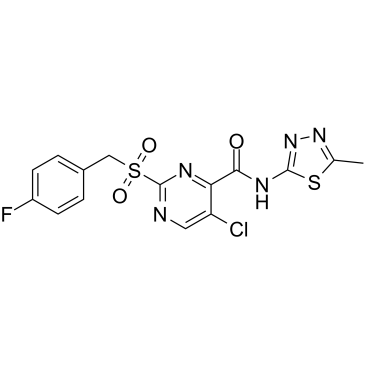| In Vitro |
PK11007 (0-120 µM; 24 hours; four p53 wild-type cell lines and fours p53 mutant cell lines) treatment results in a large viability reduction in mutant p53 cell lines MKN1 (V143A), HUH-7 (Y220C), NUGC-3 (Y220C), and SW480 (R273H/P309S) at concentrations ranging from 15 to 30 µM. PK11007 induces mainly caspase-independent cell death[1]. PK11007 (0-60 µM; 3 hours or 6 hours; NUGC-4, NUGC-3, MKN1, HUH-6, and HUH-7 cancer cells) treatment up-regulates protein levels of the p53 target genes p21, MDM2, and PUMA in a mostly concentration-dependent manner in NUGC-3 (p53-Y220C), HUH-7 (p53-Y220C) and MKN1 (p53-V143A) cells, suggesting partial restoration of transcriptional activity to destabilized p53 mutants. PK11007 also increases p53 activity in HUH-6 and NUGC-4 cells, as indicated by the increase of MDM2, PUMA, and p21 protein levels[1]. PK11007 (15-20 µM; 4.5 hours or 6 hours; MKN1, HUH-7, NUGC-3, HUH-6 cells) treatment increases transcription of p53 target genes in three mutant p53 cell lines after 6-h treatment. PUMA and p21 mRNA levels are up-regulated by a factor of 2 upon treatment of NUGC-3, MKN, and HUH-7 cells, as well as NOXA for the latter two. MDM2 levels are halved in MKN1 and NUGC-3 cells[1]. PK11007 viability reduction is potentiated by glutathione depletion. To test whether PK11007 also increases ROS levels, NUGC-3, NUGC-4, HUH-6, HUH-7, and MKN1 cells with PK11007 are incubated for 2 h. There are elevated ROS levels in all cell lines after 2 h. In the mutant p53 cells MKN1, HUH-7, and NUGC-3, however, the ROS increase is higher at 60 µM PK11007 than in NUGC-4 and HUH-6 cells, suggesting that the higher PK11007 sensitivity of the mutant p53 cell lines is mediated by a stronger ROS induction. Basal and PK11007-induced ROS levels in MKN1 cells are at least twofold higher than in other cell lines[1]. PK11007 inhibits cell proliferation, induces apoptosis and alters genes involved in cell death are all consistent with the ability of PK11007 to reactivate mutant p53[2]. Cell Viability Assay[1] Cell Line: p53 wild-type cell lines (WI-38, HUH-6, NUGC-4, SJSA-1) and p53 mutant cell lines (HUH-7, NUGC-3, SW480, MKN1) Concentration: 0 μM, 20 μM, 40 μM, 60 µM, 80 µM, 100 µM and 120 µM Incubation Time: 24 hours Result: There was a large viability reduction in mutant p53 cell lines MKN1 (V143A), HUH-7 (Y220C), NUGC-3 (Y220C), and SW480 (R273H/P309S) and in p53 WT cell line SJSA-1 at concentrations ranging from 15 to 30 µM. The p53 WT cancer cell lines HUH-6, NUGC-4 and WI-38 were less sensitive with reduced cell viability only at high concentrations of compound (60 and 120 µM). Western Blot Analysis[1] Cell Line: NUGC-4, NUGC-3, MKN1, HUH-6, and HUH-7 cancer cells Concentration: 0 μM, 15 μM, 30 μM, 60 µM Incubation Time: 3 hours or 6 hours Result: Up-regulated protein levels of the p53 target genes p21, MDM2, and PUMA in a mostly concentration-dependent manner in NUGC-3 (p53-Y220C), HUH-7 (p53-Y220C) and MKN1 (p53-V143A) cells. Also increased p53 activity in HUH-6 and NUGC-4 cells, as indicated by the increase of MDM2, PUMA, and p21 protein levels. RT-PCR[1] Cell Line: MKN1, HUH-7, NUGC-3, HUH-6 cells Concentration: 15 μM, 20 μM Incubation Time: 4.5 hours or 6 hours Result: Increased transcription of p53 target genes in three mutant p53 cell lines after 6-h treatment. PUMA and p21 mRNA levels were up-regulated by a factor of 2 upon treatment of NUGC-3, MKN, and HUH-7 cells, as well as NOXA for the latter two. MDM2 levels were halved in MKN1 and NUGC-3 cells.
|
